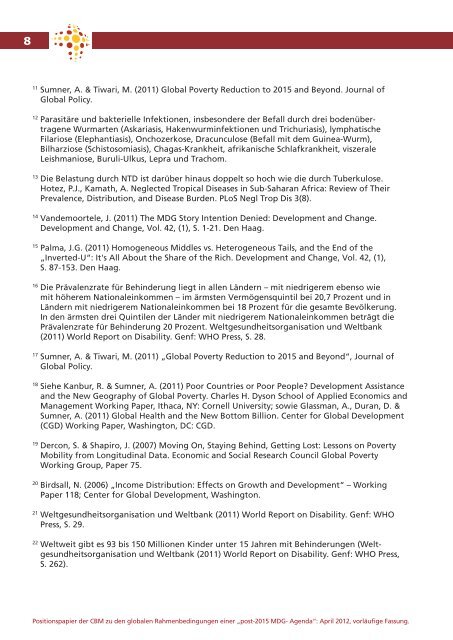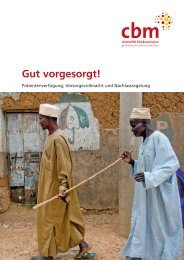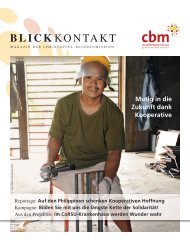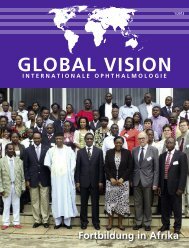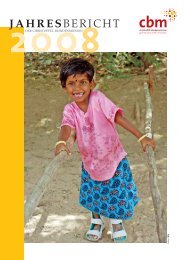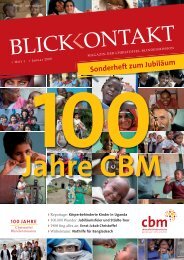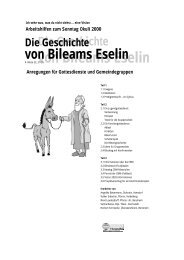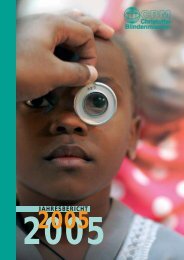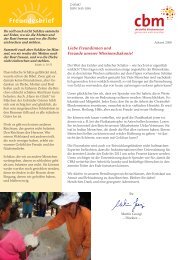CBM Positionspapier
CBM Positionspapier
CBM Positionspapier
Sie wollen auch ein ePaper? Erhöhen Sie die Reichweite Ihrer Titel.
YUMPU macht aus Druck-PDFs automatisch weboptimierte ePaper, die Google liebt.
8<br />
11 Sumner, A. & Tiwari, M. (2011) Global Poverty Reduction to 2015 and Beyond. Journal of<br />
Global Policy.<br />
12 Parasitäre und bakterielle Infektionen, insbesondere der Befall durch drei bodenübertragene<br />
Wurmarten (Askariasis, Hakenwurminfektionen und Trichuriasis), lymphatische<br />
Filariose (Elephantiasis), Onchozerkose, Dracunculose (Befall mit dem Guinea-Wurm),<br />
Bilharziose (Schistosomiasis), Chagas-Krankheit, afrikanische Schlafkrankheit, viszerale<br />
Leishmaniose, Buruli-Ulkus, Lepra und Trachom.<br />
13 Die Belastung durch NTD ist darüber hinaus doppelt so hoch wie die durch Tuberkulose.<br />
Hotez, P.J., Kamath, A. Neglected Tropical Diseases in Sub-Saharan Africa: Review of Their<br />
Prevalence, Distribution, and Disease Burden. PLoS Negl Trop Dis 3(8).<br />
14 Vandemoortele, J. (2011) The MDG Story Intention Denied: Development and Change.<br />
Development and Change, Vol. 42, (1), S. 1-21. Den Haag.<br />
15 Palma, J.G. (2011) Homogeneous Middles vs. Heterogeneous Tails, and the End of the<br />
„Inverted-U“: It's All About the Share of the Rich. Development and Change, Vol. 42, (1),<br />
S. 87-153. Den Haag.<br />
16 Die Prävalenzrate für Behinderung liegt in allen Ländern – mit niedrigerem ebenso wie<br />
mit höherem Nationaleinkommen – im ärmsten Vermögensquintil bei 20,7 Prozent und in<br />
Ländern mit niedrigerem Nationaleinkommen bei 18 Prozent für die gesamte Bevölkerung.<br />
In den ärmsten drei Quintilen der Länder mit niedrigerem Nationaleinkommen beträgt die<br />
Prävalenzrate für Behinderung 20 Prozent. Weltgesundheitsorganisation und Weltbank<br />
(2011) World Report on Disability. Genf: WHO Press, S. 28.<br />
17 Sumner, A. & Tiwari, M. (2011) „Global Poverty Reduction to 2015 and Beyond“, Journal of<br />
Global Policy.<br />
18 Siehe Kanbur, R. & Sumner, A. (2011) Poor Countries or Poor People? Development Assistance<br />
and the New Geography of Global Poverty. Charles H. Dyson School of Applied Economics and<br />
Management Working Paper, Ithaca, NY: Cornell University; sowie Glassman, A., Duran, D. &<br />
Sumner, A. (2011) Global Health and the New Bottom Billion. Center for Global Development<br />
(CGD) Working Paper, Washington, DC: CGD.<br />
19 Dercon, S. & Shapiro, J. (2007) Moving On, Staying Behind, Getting Lost: Lessons on Poverty<br />
Mobility from Longitudinal Data. Economic and Social Research Council Global Poverty<br />
Working Group, Paper 75.<br />
20 Birdsall, N. (2006) „Income Distribution: Effects on Growth and Development“ – Working<br />
Paper 118; Center for Global Development, Washington.<br />
21 Weltgesundheitsorganisation und Weltbank (2011) World Report on Disability. Genf: WHO<br />
Press, S. 29.<br />
22 Weltweit gibt es 93 bis 150 Millionen Kinder unter 15 Jahren mit Behinderungen (Weltgesundheitsorganisation<br />
und Weltbank (2011) World Report on Disability. Genf: WHO Press,<br />
S. 262).<br />
<strong>Positionspapier</strong> der <strong>CBM</strong> zu den globalen Rahmenbedingungen einer „post-2015 MDG- Agenda“: April 2012, vorläufige Fassung.


